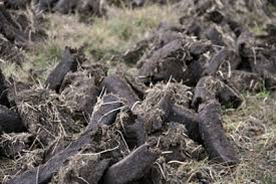There are four
types of turf that have been used in Connemara. These are White Turf, Brown
Turf, Rock Turf, Hand turf. White turf (spadach) is the top layer or a bog that
when dried could be used as kindling as it had a high percentage of sphagnum
moss. Brown turf was the next layer down and made good domestic fuel when
dried. Rock Turf (Black Turf) was more compressed and when dried was used in
forges and also as domestic fuel. Hand turf was formed by collecting and
shaping the remains of broken turf or very wet turf off cuts. This was shaped
by hand and then dried for domestic fuel.
Turf will usually only form
where slope angles are less than 15° and at altitudes between 0 and 600 meters. Throughout the centuries this valuable
Connemara commodity fueled the early industries and provided fuel for heating
and cooling. Turf has also been used as a feed stock to produce Charcoal, Gas,
Naphtha and paper in other places but it is not known if it was used like this
in Connemara.
Turf Charcoal: In England
peat was turned into charcoal by means of carbonisation. It is estimated that
peat charcoal has the same calorific value as good coal with 100kg of dried
peat yielding 36 Kg of charcoal. The charcoal was produced in kilns in which it
was carbonise it into charcoal. A major draw-back to peat charcoal is that it
is capable of holding a lot of water in proportion to its solid mass. It also
takes up moisture quicker than it can lose it. This means there is a
considerable amount of drying needed before it can be used. Once coal became
more easily available it soon replaced peat charcoal.
Turf Gas. In Sheffield in
the 19th it was found that, though the peat is found to contain gas the
quantities were too low to be commercial. However one prison in Dartmouth used
peat gas from local turf for lighting.
Turf Naphtha: Peat has an average content of 65% volatile
matter and when distilled it is possible to obtain naphtha oils. These can be
used to produce candles, mothballs and gas for lighting.
Turf Paper: The fibrous top
peat was also used to make paper in England. It was tried in Cornwall and the
process consumed over 30 tons of peat a day. The venture lasted from 1846 to
1851.
